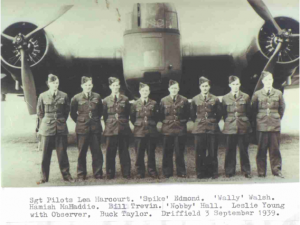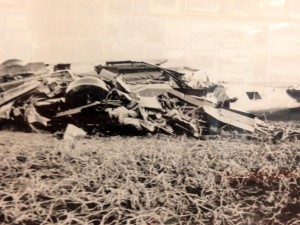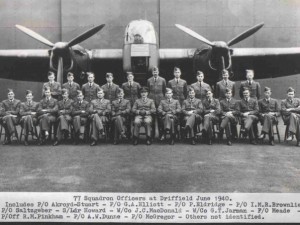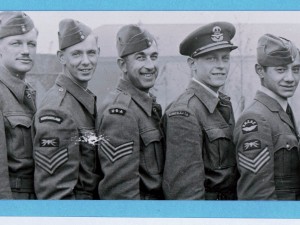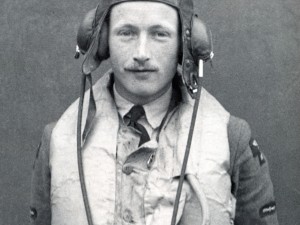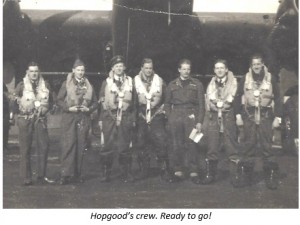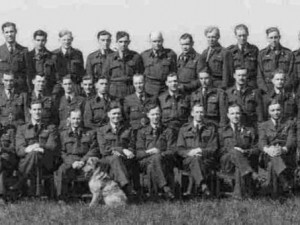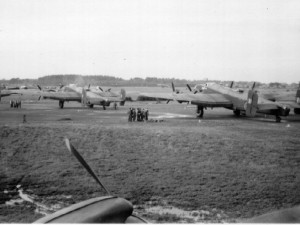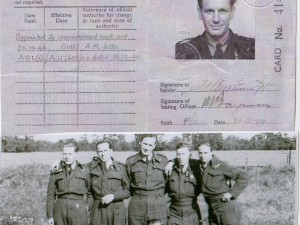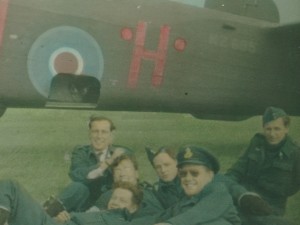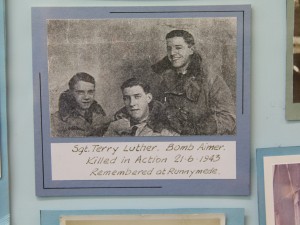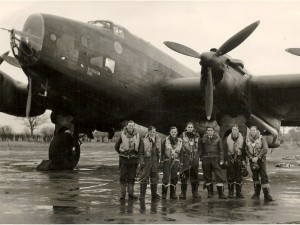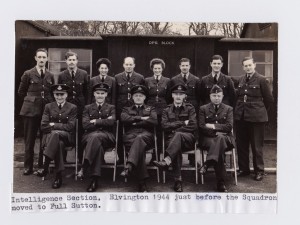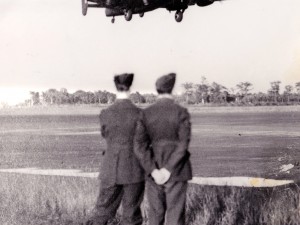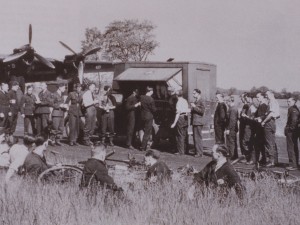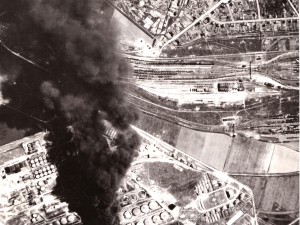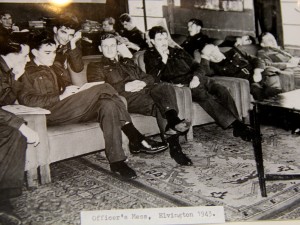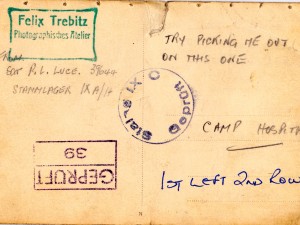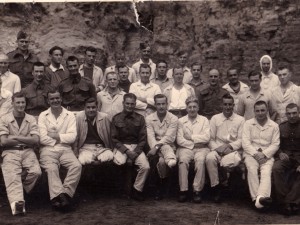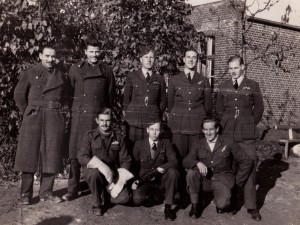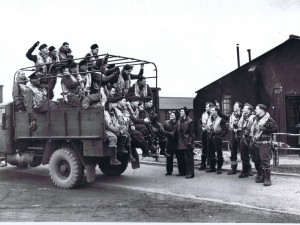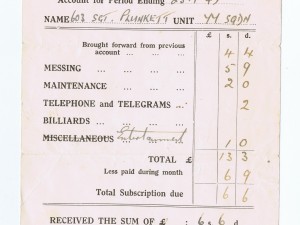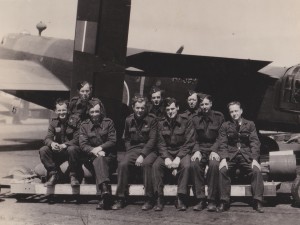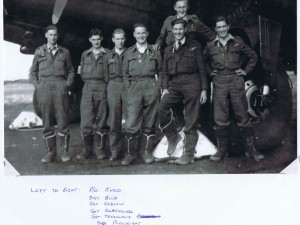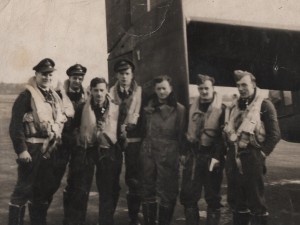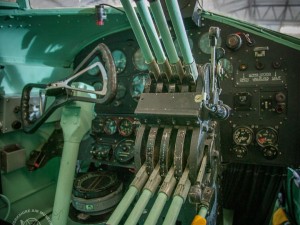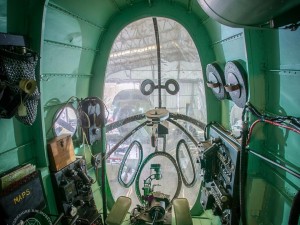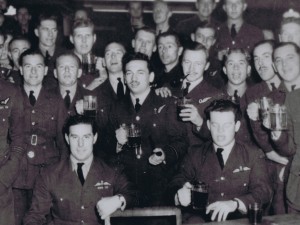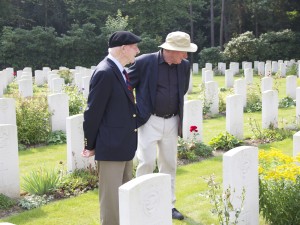77 Squadron history 1937 – 1945
(Click on the images on the right to enlarge them)
A Whitley Bomber Squadron
June 1937 to May 1942
77 Squadron was reformed at Finningley, Yorkshire, on 10th June 1937 from “B” Flight of No. 102 Squadron, and was moved in July 1937 to Honington, Suffolk. The Squadron was initially equipped, until November 1937, with Hawker Audax biplanes and they were briefly replaced by Vickers Wellesley single engine, monoplane, light bombers.
After another year In July 1938 the Squadron returned to Yorkshire as part of the newly formed 4 Group, Bomber Command, where it was to remain throughout World War II except for a brief detachment from May to October 1942 to Coastal Command in Devon.
At the outbreak of war 4 Group consisted of 6 squadrons of Whitley bombers, about 75 aircraft in all, dedicated to specialising in night bombing. Whilst theoretically the group’s maximum striking power per raid could be 300 tonnes of bombs, in fact with normal targets, and aircraft serviceability, it would have been nearer to 100-150 tonnes in total, not a devastating amount.
In November 1938 the squadron was equipped with Armstrong Whitworth Whitley Mk III, twin engine, medium bombers. A year later, from November 1939, the Mk III version was slowly replaced by the much improved Mk.V version with Rolls Royce engines. During this period the squadron was based at Driffield ,July 1938 to August 1940; Linton-on-Ouse, August 1940 to October 1940; Topcliffe, October 1940 to September 1941, and Leeming, September 1941 to May 1942. All were well equipped peacetime permanent RAF stations, with good accommodation. Before the fall of France some squadron aircraft were temporarily based there. In April 1942 remaining Bomber Command Whitley squadrons were transferred to Coastal Command.
The Whitley V was fitted with two Roll Royce Merlin X engines and was limited to a maximum take off weight of 14.4 tonne (32,500 lb). The maximum bomb load was 3.6 tonne (8,000 lb), but this load could only be carried relatively short distances and at ranges of around 1000 Km the practical bomb load was nearer 2 tonne (4,000 lb). Whilst the aircraft could attain a ceiling of 18,000 feet, at this height its handling characteristics were poor and with the limited heating provided the temperature in the cabin was unacceptably low, many crew members got frostbite during the European winter. It was however fitted with quite effective wing de-icing. A more realistic operating height was around 10,000 feet. With one rear gun turret it was inadequately armed for daylight operations. Nevertheless it compared favourably with many German bombers of the period.
The ‘phoney‘ war and the ‘Nickels’
On the 1st September 1939 the President of the USA, Franklin D. Roosevelt, through diplomatic channels, urged Britain, France, Germany, Italy and Poland to declare their affirmation to refrain from the bombing of either the civil population or unfortified cities. The British Prime Minister, Neville Chamberlain, and the German Führer, Adolf Hitler, both replied that this was already their policy, providing that any opposing force adhered to the same rule. Poland seems to have been over run by German forces before its government could reply, nevertheless both Britain and Germany still adhered to this policy for the next 9 months, until German forces invaded the Low Countries when restrictions on RAF bombing were relaxed, and eventually removed after the bombing of London by the Luftwaffe during the Battle of Britain.
As a result of this policy during the period from September 1939 until April 1940 the activities of 4 Group, apart from a few isolated bombing attacks on coastal military targets, was devoted to propaganda warfare, the dropping of leaflets, which were given the code name “Nickels”. Whilst widely acclaimed in the British press at the time as being very effective in lowering German morale, they were in retrospect assessed as having little such influence.
The leaflets were made up in large packets and securely stowed in the fuselage. On arrival at the dropping area they would be unpacked and put down the flare chute in small bundles. In low temperatures this was a slow and weary task. Each bundle was fastened by a rubber band which broke when it entered the aircraft’s slip stream, the individual leaflets would then float down to earth. With a strong wind and a dropping height of 15,000 feet the leaflets might float for many miles before they reached the ground, so the distribution could be pretty random and dispersed.
Later in the war, using the same code name “Nickels”, small magazines and news sheets were dropped over occupied Europe for the information of the locals and these were probably quite helpful and effective.
Nevertheless these raids did provide 4 Group with practical experience in navigation, reconnaissance and target location over Europe. However it soon became apparent that the Group’s aircraft were inadequately equipped, both navigationally and operationally, for crews to regularly locate targets by any other means than visual map reading, which was only practical under conditions of bright moonlight. This gave a monthly window of opportunity for accurate target location which lasted no more than about seven days, weather permitting, and it seldom was in the winter months.
Early in the war the Squadron became well known for pioneering flights. On the night of 7th March 1940 two of the Squadron’s Whitley aircraft, captained by F/Lt B.Tomlin and F/Lt G.L.Raphael, flew from Villeneuve in France to drop leaflets on the historic city of Poznan, 270 km west of Warsaw in occupied Poland. They were the first allied aircraft to fly over Poland during the war.
The Squadron lost its first aircraft, Whitley III, K8947 KN Q, of World War II on the night of 15-16 October 1939 when four aircraft, operating from a forward base in France took off in severe weather to drop leaflets over Frankfurt. They met little opposition but one of the Whitley aircraft failed to return. The aircraft’s pilot was Flight Lieutenant Roland Williams, a short service commissioned RAF officer aged 23 years. (Read more on this event on the Personalities page).
War in earnest – bombs not leaflets
May 1940
Following the German invasion of the Low Countries on the 10th May 1940 raids against Germany started in earnest. On the night of the 15/16th May a combined force of 39 Wellingtons, 36 Hampdens and 24 Whitleys attacked 18 different targets in the Ruhr area. This was the first serious strategic bombing raid against Germany. Whilst the policy of not deliberately attacking civilians was officially maintained it became more and more difficult in practice to actually avoid doing so. Although little damage or loss of life occurred through these early raids they undoubtedly caused quite a lot of concern amongst the German population. The degree of 77 Squadron participation in these raids is not easy to ascertain from available records, however the command did not suffer any loss.
In April 1940 after Germany invaded Norway, the squadron started bombing raids on the ports of Stavanger,Trondheim, and other similar targets. However as the distances involved were great the bomb load was limited. In order to carry an acceptable bomb load to these targets some aircraft had to refuel in northern Scotland.
At the beginning of the war the Wellingtons, of 3 Group, and the Hampdens, of 5 Group, had been intended to form a daylight ‘heavy bomber’ force, able to carry out precision visual attacks on permitted targets. It was believed that by flying in formation that they would have adequate combined defensive fire power to beat off fighter attacks. However in practice this was found to be a fallacy and after several raids experiencing very high losses it became obvious that precision daylight operations were unsustainable.
The Air Staff consequently concluded that any further daylight bombing raids by ‘heavy’ aircraft, particularly against inland targets, could only be successfully carried out with substantial escort fighter cover, which was, however, not available at that time. As a result all three Groups of the ‘heavy bomber’ force began to jointly take part in night operations, which were no longer the sole preserve of 4 Group. The German Luftwaffe encountered a similar problems in the Battle of Britain and consequently also had to switch its bombing offensive from day to night in October 1940, however they had the navigation aids to do so effectively whereas the RAF did not.
When the daylight Battle of Britain officially ended in October 1940 the German bombing offensive switched to night operations and the preparations for the invasion of England continued. Whilst Fighter Command activity declined, as they were unable to carry out effective night defensive action, Bomber Command continued to carry out many raids against the Channel Ports, thereby considerably hampering the invasion preparations.
Adolf Hitler issued the directive for the invasion of Russia, ‘Operation Barbarossa’, in December 1940. It would appear he was hoping either to defeat Britain through a successful invasion, or at least reach an ‘arrangement’ with the British Government, before invading Russia in the spring of 1941. The Bomber Command attacks on the Channel Ports not only slowed down the invasion preparations but also influenced the German Navy to advise Hitler that as they had neither the mastery of the sea nor air in the Channel area that an invasion could fail. As result in May 1941, following the occupation of Yugoslavia, many German Army and Air Force units were moved from Northern France to Poland in preparation for the attack on Russia. Although the plans for the invasion of Britain were not officially abandoned they did in fact peter out and the bombing of Britain sharply declined.
Bomber Command continued to carry out frequent attacks, although with a relatively small number of aircraft, on a large number of different German targets throughout 1941. Although these raids did a great deal to maintain morale in Britain, and amongst the civil population in occupied Europe, the opinion now is that although wide spread damage was done its effect on the German war industry, and civilian morale, was negligible. Although some effective raids were carried out on a few of the smaller ports, such as Lübeck, it was not until 1942, with the carrying out of the 1,000 bomber raids, that the real potential of Bomber Command began to become apparent.
Attacked on the Ground
Whilst at Driffield on 14 August 1940 the airfield was attacked by Junkers 88 aircraft of the Luftwaffe from Scandinavian bases as part of the opening gambit of the Battle of Britain. Twelve Whitley bombers of 77 and 102 Squadrons were destroyed and the airfield badly damaged. Thirteen airmen and soldiers were killed. Afterwards 77 squadron had to move to Linton-on-Ouse as Driffield was no longer fit for operational use.
Losses and casualties, 1939 – 1940
Between the outbreak of war in 1939 and the end of December 1940 the squadron lost 27 aircraft on operations, of which 2 crashed on return and 2 ditched. The number of aircraft and crews lost were almost twice the squadron’s established strength. The casualties were 92 aircrew killed or missing believed dead and 21 taken prisoners of war. Near the end of this period Berlin was attacked on several occasions and Turin twice, the latter target was at the extreme range for Whitley aircraft. Five aircraft were lost in the raids on Berlin.
Losses and casualties, 1941
During the year 1941 the squadron lost 30 aircraft on operations, of which one was in an accident, 2 crashed and 3 ditched. During the year the total number lost during the year was again around double the normal squadron strength. The casualties were 112 aircrew killed or missing believed dead and 29 taken prisoners of war. Targets included Berlin, Hamburg, Bremen and the Ruhr. Another five aircraft were lost in raids on Berlin and five in raids on Hamburg.
However Bomber Command’s ability to achieve any truly effective strategic bombing of Germany at night was now being questioned at both Air Ministry and Cabinet level, although this view was challenged the year 1941 was a period of uncertainty. The new four engine heavy bomber aircraft were just entering squadron service, but only in small numbers as serious problems had been encountered which slowed down the process of introduction significantly. For example the large ‘heavy’ twin-engine Manchester, which was introduced on squadrons in November 1940, was a failure, it experienced poor serviceability and heavy losses until it had to be withdrawn from operations. AVRO redesigned it with four engines as the Lancaster which was an outstanding success following its introduction on squadrons early in 1942.
The bombing accuracy and general effectiveness of the force of Whitley bombers was continually questioned, particularly in the light of the relatively high losses encountered. The aircraft was inadequate for the task it was being assigned to. Although new equipment, such as the navigational aid GEE and the DR compass, was being introduced this was being fitted to the Wellington and the new four engine types, not to the aging Whitley.
With Germany’s attack on Russia in June 1941, and the entry of the USA and Japan in to the conflict in December 1941, the war escalated from a local conflict, mainly between Britain and Germany, into a truly World War.
Bomber Command was continuing the fight against Germany with dedication and great bravery; its effect however at this stage, on both the morale of the German people and armament production, did not appear to those in command of overall strategy to be sufficient to alter the course of the war. Although growing in size It was still a relatively small and inadequately equipped force. Nevertheless the continuing attack against German homeland significantly bolstered the morale of the British people and gave substantial hope to those in the occupied territories of Europe.
Losses and Casualties in 1942, up to May
During the early part of the year 1942, prior to transfer to Coastal Command in May, the squadron lost 11 aircraft, 4 of which crashed and one ditched. The casualties were 43 aircrew killed or missing believed dead and 5 taken prisoners of war. Targets included St Nazaire, Emden, Rostock and Wilhelmshaven. 3 aircraft were lost in one raid on Wilhelmshaven. The raid on Rostock, in late April, was the first of a series of raids on the Baltic seaports, which were easy to locate in clear weather conditions and consequently very effective.
In the Bomber Command Order of Battle for the 9th January 1942 the squadron consisted of 2 flights and had 17 Whitley Mk V aircraft on “unit charge”. Soon after this the strength was expanded to 3 flights with 27 aircraft but in May 1942 the squadron was transferred to Coastal Command following the withdrawal of Whitley aircraft from front line Bomber Command operations.
The total cost in crew of Whitley Operations on 77 Squadron
During the whole period the Squadron was operating Whitley aircraft with Bomber Command, September 1939 to May 1942, 1,687 operational sorties were flown on 239 raids, mostly over France and Germany, and 69 aircraft were lost, of which 65 were on operations, an average loss rate of 4%.
It is believed that the Squadron carried out more raids and suffered more losses than any other Whitley squadron (‘Bomber Command War Diaries’, Middlebrook & Everitt, 1986). The probability of a squadron aircrew member completing 30 operations, the number in a tour of duty, was only around 30%.
The casualties suffered were 245 aircrew either killed or missing believed dead and 59 taken prisoners of war. Ten ground personnel were also killed, mostly during the enemy attack on Driffield. A further 48 aircrew whose aircraft were lost either survived, evaded capture or were interned in a neutral country.
Decorations
Throughout the period of Whitley operations a total of 29 DFC and 31 DFM were awarded to Squadron members.
FIRST HUNDRED CASUALTIES
Out of the first hundred casualties, between the outbreak of war and December 1940, 70% were RAF regulars and 30% RAFVR wartime volunteers. Many of the pilots referred to as regulars were short service commission officers who had joined the RAF just before the war, and in fact their training had been little different to that received by VR pilots.
SECOND HUNDRED CASUALTIES
In the second hundred casualties, between January and November 1941, the regular RAF component dropped to 10% and that of the RAFVR increased to 73%. A further 17% were from Dominion air forces who had been sent to help the RAF.
The Crew of a Whitley
The Whitley bomber was generally manned by a crew of five, consisting of two pilots, one of whom in the early days did the navigation; an observer who at first acted as bomb aimer and gunner but later took over the navigation from the co-pilot, and two ‘wireless operator air gunners’ (WAG) who could carry out either duties. A large proportion of the pre-war sergeant pilots were employed as co-pilots on bombers, whilst many of the captains were short service officers.
The number of aircrew on the squadron varied but was about 75 in 1939 but rose to over 100 by 1942. Up until late 1940 air gunners and wireless operators were drawn from qualified ground crew and were neither considered regular aircrew nor given the rank of sergeant, many flew as Leading Aircraftsmen. Some recruited from ground crew, were mustered for ‘air gunner’ duties only.
It is estimated that at least 500 aircrew members served with the squadron on Whitleys. However it should be remembered that of the estimated 150 to 170 crew who managed to complete a first tour of operations on Whitleys, most were required to carry out a second tour later in the war, consequently there were very few surviving former Whitley aircrew at the end of the war.
Coastal Command
May to October 1942
Soon after Air Marshal Harris took over as Commander of Bomber Command in February 1942, the Whitley was withdrawn from use as a night bomber. Not enough of the newer aircraft were ready to replace it so 77 Squadron temporarily joined 19 Group in Coastal Command, together with its Whitley aircraft. The squadron moved to Chivenor airfield in Devon on 6th May 1942. The operations now carried out consisted of convoy escorts, antisubmarine patrols and shipping strikes off South West England.
The Whitley was only marginally effective in carrying out patrols against German U boat activity off SW Britain as they were neither fitted with the new air to surface vessel detection radar equipment (ASV) nor the Leigh searchlight. Nevertheless they were not required to carry heavy bomb loads and were able to undertake long over water flights with a full fuel load and depth charges. Nevertheless in retrospect it would seem that often insufficient fuel reserves were allocated on these flights, a factor which probably contributed to losses as much as enemy action.
German Records show that 5 U-boats were sunk in the Bay of Biscay by Coastal Command during the period that 77 Squadron was with it. One of these, U-boat 705, was sunk by a Whitley of 77 Squadron when on patrol on the 7th September 1942. Whilst other attacks no doubt took place, and some of the missing aircraft may have been involved, this is the only positive ‘kill’ credited to 77 squadron, nevertheless it was 20% of the Command’s successes during the period. However patrolling aircraft contributed towards the offensive as they frequently gave cause for U Boats to make unscheduled dives, thereby disrupting operations against shipping.
During the attachment a total of 6 aircraft were lost on operations and the casualties suffered were 27 aircrew either killed or missing believed dead and 7 taken prisoners of war. One DFC was awarded in October.
The squadron joined Coastal Command before the ‘1000 bomber raids’ mounted by AM Harris in 1942, so did not take part in them. When the squadron returned to Bomber Command later in the year, October 1942, its transformation in to a four engine bomber force was well underway.
Return to Bomber Command
Halifax Operations
October 1942 to May 1945, Elvington
The Squadron moved to Elvington airfield, just outside York, and commenced intensive training on Halifax II aircraft on the 8th October 1942 but was not declared operational until the end of January 1943. Unlike most of its previous bases, which were pre-war regular RAF stations, this was a recently constructed temporary camp with wooden buildings and Nissen hut accommodation. All with a wartime ambience and atmosphere, which was far from the luxury and comfort previously experienced.
February and March 1943
The squadron’s first raid using the Halifax was against the U-boat base at Lorient, France, on the 4th February 1943, this was followed by several raids mainly on similar targets. During February and March 1943 the squadron flew 152 sorties on 22 raids, with the loss of only 3 aircraft, a loss rate of 2%. The first loss occurred on the 10th March 1943 when two aircraft were lost on a raid on Munich, and another on 29th March 1943 on Berlin.
However, now the Battle of the Ruhr commenced and although this was before a directive had been issued this was later looked upon as de facto marking the start of Operation Pointblank for the RAF. So started 77 Squadron’s worst, yet undoubtedly greatest year.
April, May and June 1943
During the three months April, May and June 1943 the squadron carried out 356 sorties on 29 raids, 19 aircraft went missing on operations and 2 were lost in take-off accidents, aircrew casualties amounted to 122 killed or missing believed dead and 22 taken prisoners of war. The average loss rate was 5.8 % which meant that only about 1 crew in six could be expected to complete a tour of 30 operations.
At the time of the Bomber Command Order of Battle on 4th March 1943 the Squadron had 18 Halifax Mk2 aircraft on unit charge, and around 150 to 200 aircrew. So that during this battle, over a period of three months, the Squadron lost as many aircraft and crews as its established strength. Of course as crews were lost they were progressively replaced with new ones from the heavy conversion training units (HCU).
July, August and September 1943
During July 1943 the squadron carried out 141 sorties on 8 raids with the loss of only 3 aircraft, a loss rate of only 2 %. At the end of July the Battle of Hamburg began. However during the battle attacks also maintained against various other cities including Berlin and Nuremberg.
During the two months, August and September 1943 the Squadron carried out 284 sorties on 18 raids losing 21 aircraft, the average loss rate had again increased, now to 7.5%. Casualties amounted to 119 killed or missing believed dead and 32 taken prisoners of war, three aircrew evaded capture and returned to the UK. The estimated probability of completing a tour of operations had declined to 1 crew in 10. Again within two months the Squadron had lost on operations almost the equivalent of its establishment in aircraft and aircrew. Nevertheless about this time the squadron began progressively expanding into three flights, each of about 10 aircraft, with a total of 200-250 aircrew.
October and November 1943
On the 12th October 1943 Wing Commander John A Roncoroni took over as the Squadron commander at a period when the Command had begun to experience some of its most severe losses during the war. Aircrew were scarcely able to even get to know each other’s names, never mind make friends. During October and November the squadron carried out 157 sorties on 11 raids losing 7 aircraft on operations and one was involved in a collision with another aircraft on return from operations, an average loss rate of 5.5%. Casualties amounted to 45 killed or missing believed dead and 10 taken prisoner of war. Two aircrew members evaded capture. The odds on completing a tour had improved to 1 crew in 6.
Battle of Berlin. November 1943 to March 1944
On the 3rd November 1943 Air Marshal Arthur Harris wrote to the Prime Minister, Winston Churchill, saying that
“We can wreck Berlin from end to end if the U.S.A.A.F. will come in on it. It will cost between 400-500 aircraft. It will cost Germany the war.” [quoted in the official history v.ii, page 190].
On the 18th of November 1943 the Battle of Berlin commenced, although for tactical reasons many other targets were included, the period is usually referred to by this name.
During the battle 16 major main force raids were mounted against Berlin and 16 against other targets, in addition numerous small diversionary raids were also carried out. 77 Squadron participated in five of the main force raids against Berlin.
Whilst Harris had indicated to Churchill that the USAAF should participate, this was not in fact a feasible proposition. The 8AAF was a ‘daylight’ force, the various squadrons flying in formation to form a vast aerial armada. This was an essential part of the strategy against fighter aircraft, and it could only take place in daylight. Before setting forth from East Anglia up to two hours often elapsed since take-off before the armada set off for Germany. This time coupled with the small window of opportunity arising from the reduced hours of daylight during winter made the carrying out of 8AAF raids on Berlin was virtually impracticable. In addition of course formation flying was often impossible during winter due to heavy cloud. It was not until the 6th March 1944 that 8AAF escorted by long range fighters managed an attack on Berlin. However they did carry out raids on many other less distant targets during this period.
During the “battle” Halifax II and V aircraft, with which the Squadron was equipped, suffered a greater loss rate than any other aircraft type. According to data in the official history, “The Strategic Air Offensive Against Germany, 1939-1945 “, in December 1943, January 1944 and February 1944 within the whole command 149 aircraft of these types were lost on 1526 sorties, an overall loss rate of 9.8%. Had aircrews continued operating Halifaxes at this loss rate it is estimated that only one aircrew in 22 would have completed a tour of 30 operations.
During the three months December 1943, January and February 1944 the squadron carried out 14 raids involving 143 sorties but lost 19 aircraft on operations and 1 in an accident, giving the terrible overall loss rate of of 13.3%. Casualties amounted to 103 aircrew killed or missing believed dead and 35 taken prisoners of war, one evaded capture, and 7 were killed in an accident. The Squadron strength dropped to almost half its establishment and replacements were not coming in fast enough from the Heavy Conversion Units to rebuild it to strength.
Whilst during January and February 1944 the squadron only took part in five raids on German targets the losses incurred were particularly severe.
With a total of 16 aircraft missing on these five consecutive raids the average loss rate for the squadron was 20.7%. The estimated probability of a crew participating in all five raids and surviving them was only 31%, that is about 1 in 3. In these five raids the squadron’s casualties were 87 aircrew killed and 26 taken POW, a total of 113.
Following the raid on Leipzig ACM Sir Arthur Harris withdrew Halifax II and V aircraft from operations against German targets, and 77 squadron was no longer participating in the Battle of Berlin.
The effects of bombing, on both German war production and civilian morale, was slow but cumulative. However the results were rarely measurable by intelligence with confidence and aircrew had to frequently return to targets which in the first instance had seemed demolished or at least devastated. Generally aircrew looked towards completing their tour of 30 operations rather than the imminent surrender of Germany. The pre-war Douhet concept of mass bombing leading to devastation, followed by unconditional surrender, never materialised either after the Battle of Britain, or later in Operation Pointblank.
During Operation Pointblank an increase in strength and improvement in technology in the Luftwaffe fighter arm occurred in spite of attacks on the German aviation industry, this led to higher allied losses than originally expected. However overall this advantage had only been achieved by Germany considerably reducing its production of bomber aircraft, and its ability to retaliate by bombing targets in the United Kingdom. Nevertheless although Operation Pointblank did not achieve the unconditional surrender of Germany to the Allies, which was predicted by Air Marshal Harris, it unquestionably substantially weakened Germany and was considered by many, including Field Marshal Kesselring, to be the main factor which contributed to victory by the Allies by May 1945.
After being taken off German targets on the 24th and 25th of February the squadron carried out 21 mining sorties in the Kattegat without any loss.
March and April 1944
The attack against the transportation infrastructure of north-east France.
The Squadron now commenced a period during which raids were mainly against marshalling yards, railway installations and other targets in Northern France, the raids were aimed at destroying the transportation infrastructure prior to the invasion of Europe. It was considered that as these targets were not generally well protected by fighters and flak that the Halifax loss rate would be less.
On the other hand because the allies wished to avoid causing death and injury to French civilians living nearby, precision bombing was required, and area bombing, as carried out on German cities, was unacceptable. Consequently many raids were carried out at a much lower height with the result that aircraft became more susceptible to damage from light flak. In addition the Luftwaffe began to move some of its fighter force to the defence of French targets and overall losses soon began to increase, although not severely.
However the Battle of Berlin was practically over and within a month the Air Ministry changed its priorities in respect of the deployment of the whole bomber force prior to Overlord, the invasion of Europe, and from March onwards most Bomber Command squadrons were operating on pre-invasion targets in France.
During the two months March and April the squadron carried out 290 sorties on 27 raids. 6 aircraft were lost giving a loss rate of 2.1%. At this level the estimated probability of completing a tour had improved to 53%, or roughly 1 crew in 2.
In March 1944 the squadron was told that Elvington was to be handed over to two Free French Squadrons, №346 (Guyenne) and №347 (Tunisie). Following the arrival of French personnel aircrew were introduced to Tannoy announcements in French and free wine in the messes. A French station commander was appointed and all British ground staff were progressively replaced by French personnel.
77 Squadron at Full Sutton
May 1944 – 1945
On 14th May 1944 the Squadron aircraft and aircrew moved to Full Sutton airfield nearby and at the same time commenced conversion to Halifax III aircraft, which had better performance and equipment than the Mk.II & MK.V series previously used.
The beginning of June 1944 and D-Day passed with full squadron participation with support to the ground forces but without any operational losses. The frequency of operations was stepped up but most flying was of a tactical nature in support of the the invasion forces. The strategic bombing of Germany was significantly reduced.
The disastrous Sterkrade raid
However on the 16th June 1944 a strategic raid was called for on the synthetic oil plant at Sterkrade, in the Ruhr, which turned out to be the most disastrous in the squadron’s history. 25 aircraft were dispatched, 1 failed to take off, 1 returned early, 6 went missing and 1 ditched in the North Sea but the aircrew were rescued. On this raid 27 aircrew were killed or missing believed dead, 16 were taken prisoners of war and 7 returned safely to the UK. It was the Squadron’s heaviest losses on a single raid.
A total of 162 Halifaxes and 137 Lancasters took part in this raid. Cloud covered the whole of the route and the target up to 14,000 feet. The target was an important synthetic fuel oil factory. At the target the Pathfinder markers were little more than a faint glow through the cloud cover. The attacking force approached the target in two waves passing to the north and south of Rotterdam. This confused the enemy for a time but as the force approached Sterkrade they also drew close to the German fighter beacon at Bocholt where the Luftwaffe fighter controller had assembled his forces. About 21 aircraft were shot down by fighters and 10 by flak. 22 of the lost aircraft were Halifax Mk 3. The overall Halifax Loss rate was 13.6% of the 162 Halifaxes taking part in the raid.
From post war examination of German records the effect of the raid appears to have been negligible, local records give that 21 Germans and 6 foreign workers were killed, and 18 houses damaged. Nevertheless from reconnaissance photos following the raid nine units at the factory appeared to have been damaged.
The squadron was supported by hundreds of dedicated groundcrew. The next to last picture in the sidebar shows a proud group of three, Peter Sharpe bottom left, in August 1944 with his completed nose art of Pluto above.
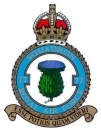






 info@77squadron.org.uk
info@77squadron.org.uk

